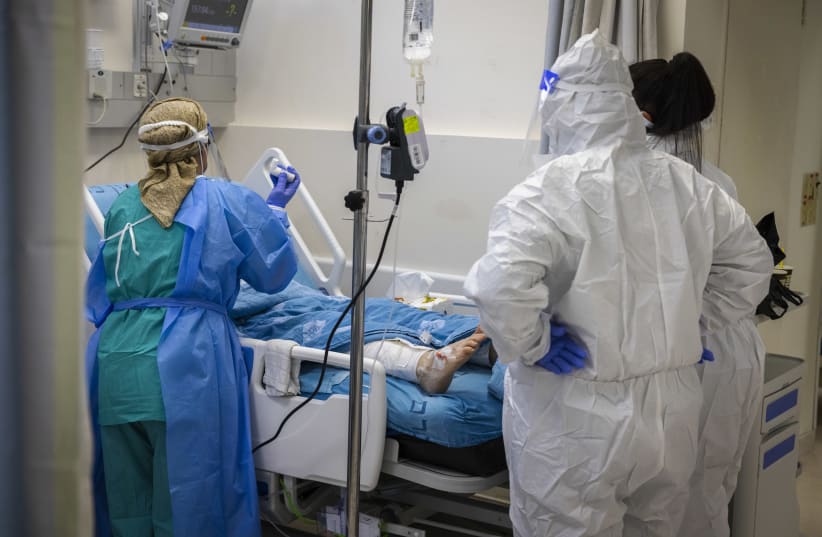Since the beginning of the summer, when the government led by Prime Minister Naftali Bennett took office, the number of seriously ill corona patients has been considered the crucial factor when monitoring the severity of the situation in Israel.
During the worst months of the pandemic in the different waves, seriously ill patients have always represented an unprecedented challenge to the hospitals, in light of the high demands that caring for them puts on medical personnel, from wearing special protective gear to the need for constant assistance.
As Israel prepared to face the Omicron wave last month, experts predicted that considering how highly infectious was the variant, the country could expect up to 2,500 new patients a day. To ensure that the authorities would not be forced to impose heavy restrictions to avoid the collapse of the health system, Bennett asked it to prepare for as many as 4,000 patients.
In January 2021, when the country registered a record number of serious patients, there were 1,200 new cases a day.
Over the past 10 days, Israel has continuously hit a new record of virus carriers, increasing from 12,000 a day to 48,000, with experts believing that the real number of those infected is likely to be much higher.
Serious morbidity tends to show up several days after general morbidity.
The number of serious patients, while still limited, has also started to increase. There were 283 patients on Thursday compared with 136 a week earlier. In addition, 284 new patients were classified as serious over the previous seven days, marking an increase of 189% over the previous week.
Yet when it comes to the Omicron wave, the number itself does not express the full picture, because until now, symptoms and the general situation of these patients appear to be much better than in previous waves, according to two experts.
“Omicron causes a milder disease, definitely among those who are triple vaccinated, and possibly also among the unvaccinated,” said Prof. Jonathan Halevy, president of Shaare Zedek Medical Center in Jerusalem. “This is true both for people who are sick in general and for those who are in a serious condition. There is more dry cough and much less loss of smell and taste. Crucially, we are seeing that the infection is affecting more the upper respiratory system and much less the lungs.”
Halevy said that is why fewer patients are ending up on ventilators. As of Thursday, there were 65 intubated individuals; a week earlier there were 40.
“However, unvaccinated patients are still at risk,” he said. “At Shaare Zedek for example, we have one person in their thirties who is on ECMO,” referring to the extracorporeal membrane oxygenation machines that are used for the most severe patients.
According to Halevy, Omicron appears milder compared with previous variants for all age groups, although the elderly are still more at risk.
“One thing that we have read from publications abroad and we have not seen yet in Israel is a high number of hospitalized young children,” he said. “Our pediatric departments are full, not due to COVID but rather other winter respiratory diseases.”
Patients also tend to recover faster, and the mortality rate is much lower.
According to Halevy, while the number of serious patients is expected to increase significantly, what has been observed so far regarding their general condition will remain true.
“I think that the nature of the variant is such that it is going to cause much less severe disease, and this is not going to change,” he said. “Of course, those who are in danger from both Omicron and Delta are the unvaccinated, those who have not received the third shot, and the elderly with serious underlying conditions who are not necessarily prone to complications from Omicron but from these conditions.”
Epidemiologist Prof. Nadav Davidovitch, director of Ben-Gurion University’s School of Public Health and an adviser to the Health Ministry, expressed a slightly different view.
“It seems that fewer patients need a ventilator compared with during the Delta wave, and those who are hospitalized are released earlier,” he said. “We are not seeing the phenomenon of people stuck on ventilators for a long time as much as before. However, we are still at the beginning of this wave and we need to be cautious and see how things develop.”
According to Davidovitch, it is still possible that the variant will end up causing more serious symptoms.
He noted that the information that comes from abroad from countries where Omicron hit earlier than Israel – which also points to less severe disease – is significant, but might not necessarily be completely relevant.
“Every population has its own characteristics,” Davidovitch said. “It is also important to remember that Omicron has hit Israel as the country is also experiencing a high level of flu cases and other winter diseases, and therefore we need to be careful that the health system does not get overwhelmed.”

